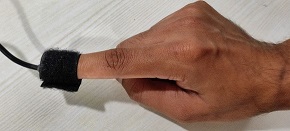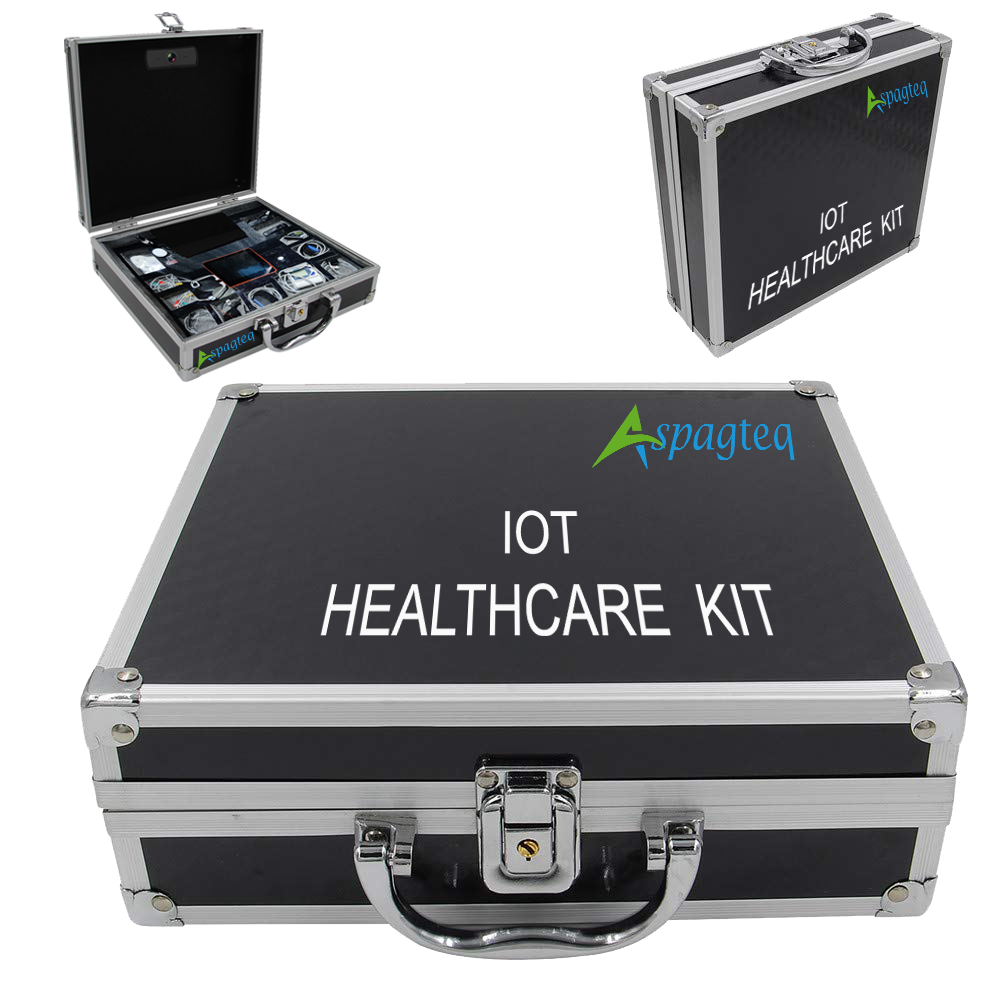IoT
Healthcare Kit
Maximise the utilisation of all connected medical devices

IOT Healthcare Kit allows you to measure more than 11 different biometric parameters such as pulse, breath rate, oxygen in blood, electrocardiogram signals, blood pressure, muscle electromyography signals, glucose levels, galvanic skin response, lung capacity, snore waves, patient position and airflow. This broad sensing portfolio makes this kit the most complete eHealth platform in the market.
We offer broad range of both wired and wireless sensors:
Pulse and Oxygen in Blood (SPO2)
Sensor features
Description: Pulse oximetry, a noninvasive method of indicating the arterial oxygen saturation of functional haemoglobin.
 A pulse oximeter sensor is useful in any setting where a patient’s oxygenation is unstable, including intensive care, operating, recovery, emergency and hospital ward settings, pilots in unpressurised aircraft, for assessment of any patient’s oxygenation, and determining the effectiveness of or need for supplemental oxygen.
A pulse oximeter sensor is useful in any setting where a patient’s oxygenation is unstable, including intensive care, operating, recovery, emergency and hospital ward settings, pilots in unpressurised aircraft, for assessment of any patient’s oxygenation, and determining the effectiveness of or need for supplemental oxygen.
The sensor needs to be connected to the specific SPO2 jack connector in board and it works with direct connector power supply.
Measurement:

ECG
The Electrocardiogram Sensor (ECG) has grown to be one of the most commonly used medical tests in modern medicine. Its utility in the diagnosis of a myriad of cardiac pathologies ranging from myocardial ischaemia and infarction to syncope and palpitations has been invaluable to clinicians for decades. The accuracy of the ECG depends on the condition being tested. A heart problem may not always show up on the ECG. Some heart conditions never produce any specific ECG changes. ECG leads are attached to the body while the patient lies flat on a bed or table.
Sensor features
Description: The electrocardiogram (ECG) is a diagnostic tool that is routinely used to assess the electrical and muscular functions of the heart. The sensor use “Continuous telemetry electrocardiogram” for a prolonged monitoring including the use of three ECG electrodes.

The sensor needs to be connected to the specific ECG jack connector in board and it works with direct connector power supply.
Schematic representation of normal ECG 
Measurement:

Airflow
Normal respiratory rates and changes in respiratory rate are broad indicators of major physiological instability, and in many cases, respiratory rate is one of the earliest indicators of this instability. Therefore, it is critical to monitor respiratory rate as an indicator of patient status. Airflow sensors can provide an early warning of hypoxemia and apnea.
Sensor features
Description: The nasal / mouth airflow sensor is a device used to measure the breathing rate in a patient in need of respiratory help or a person. This device consists of a flexible thread that fits behind the ears and a set of two prongs that are placed in the nostrils. Breathing is measured by these prongs. The specifically designed cannula/holder allows the thermocouple sensor to be placed in the optimal position to accurately sense the oral/nasal thermal airflow changes as well as the nasal temperature of the air. Comfortable, adjustable, and easy to install.

The sensor needs to be connected to the specific Airflow jack connector inboard, and it works with a direct connector power supply.
Measurement:
| Parameter | Unit | Range |
| Respiratory rate | PPM (Peaks per minute) | 0-60 ppm |
| Breathing intensity | Volts | 0-3,3V |
Blood Pressure Monitor
Blood pressure is the pressure of the blood in the arteries as it is pumped around the body by the heart. When your heart beats, it contracts and pushes blood through the arteries to the rest of your body. This force creates pressure on the arteries. Blood pressure is recorded as two numbers—the systolic pressure (as the heart beats) over the diastolic pressure (as the heart relaxes between beats).
Sensor features
Description: Monitoring blood pressure at home is important for many people, especially if you have high blood pressure. Blood pressure does not stay the same all the time. It changes to meet your body’s needs. It is affected by various factors including body position, breathing or emotional state, exercise and sleep. It is best to measure blood pressure when you are relaxed and sitting or lying down.
 High blood pressure (hypertension) can lead to serious problems like heart attack, stroke or kidney disease. High blood pressure usually does not have any symptoms, so you need to have your blood pressure checked regularly.
High blood pressure (hypertension) can lead to serious problems like heart attack, stroke or kidney disease. High blood pressure usually does not have any symptoms, so you need to have your blood pressure checked regularly.
SPECIAL FEATURES:
- Automatic measurement of systolic, diastolic, and pulse
- 80 measurement results with time & date stored in the device
KEY SPECIFICATIONS
Measurement method: Oscillometric system
Measuring range: Pressure 0-300 mmHg
Pulse 30~200 p/min
Measuring accuracy: Pressure ≤±3 mmHg
Pulse ≤ 5%
Operating environment: Temperature 10-40℃
Relative humidity ≤ 80%
The sensor needs to be connected to the specific Blood Pressure Monitor jack connector in board and it works with internal rechargeable battery. Use the Blood pressure specific cable in order to charge the sensor connected to board.
Measurement:
| Parameter | Unit | Range |
| Systolic pressure | mm Hg | 0-300 mmHg |
| Diastolic pressure | mm Hg | 0-300 mmHg |
| Pulse | ppm | 30~200 ppm |
Glucometer
Despite widely variable intervals between meals or the occasional consumption of meals with a substantial carbohydrate load, human blood glucose levels tend to remain within the normal range. However, shortly after eating, the blood glucose level may rise, in non-diabetics, temporarily up to 7.8 mmol/L (140 mg/dL) or a bit more.
Sensor features
Description: Glucometer is a medical device for determining the approximate concentration of glucose in the blood.  A small drop of blood, obtained by pricking the skin with a lancet, is placed on a disposable test strip that the meter reads and uses to calculate the blood glucose level. The meter then displays the level in mg/dl or mmol/l.
A small drop of blood, obtained by pricking the skin with a lancet, is placed on a disposable test strip that the meter reads and uses to calculate the blood glucose level. The meter then displays the level in mg/dl or mmol/l.
The sensor needs to be connected to the specific glucometer jack connector in board and it works with internal batteries.
Temperature
Body temperature depends upon the place in the body at which the measurement is made, and the time of day and level of activity of the person. Different parts of the body have different temperatures.
The commonly accepted average core body temperature (taken internally) is 37.0°C (98.6°F). In healthy adults, body temperature fluctuates about 0.5°C (0.9°F) throughout the day, with lower temperatures in the morning and higher temperatures in the late afternoon and evening, as the body’s needs and activities change.
Sensor features
Description: The temperature sensor allows you to measure this key parameter for body monitoring. Its measure the human body temperature with a 0.1 ºC maximum desviation.
 It is of great medical importance to measure body temperature. The reason is that a number of diseases are accompanied by characteristic changes in body temperature. Likewise, the course of certain diseases can be monitored by measuring body temperature, and the efficiency of a treatment initiated can be evaluated by the physician.
It is of great medical importance to measure body temperature. The reason is that a number of diseases are accompanied by characteristic changes in body temperature. Likewise, the course of certain diseases can be monitored by measuring body temperature, and the efficiency of a treatment initiated can be evaluated by the physician.
The sensor needs to be connected to the specific Temperature jack connector in board and it works with direct connector power supply.
Measurement:
|
Parameter |
Unit |
Range |
|
Body Temperature |
Degree Celsius (°C) |
0-50ºC |
EMG
Spirometer
GSR
Body Position
Snore
Visualising Data
Scope of Learning
Get Started
It’s Never Too Late or Too Early to Get Started
Our solutions have helped a variety of partners raise their platform’s visibility and effectiveness. We could do the same for you.

